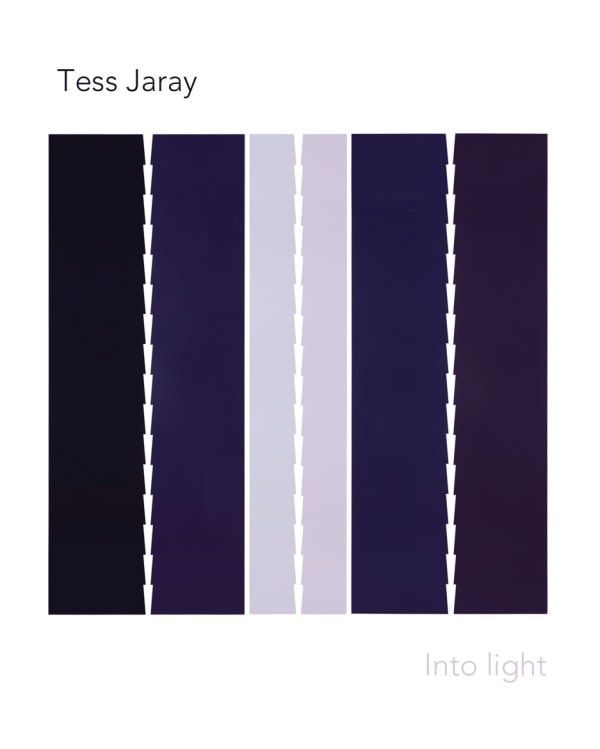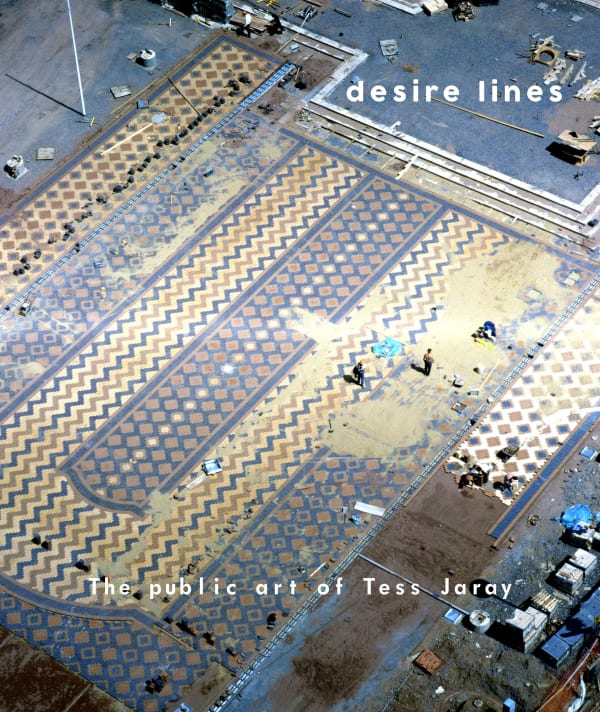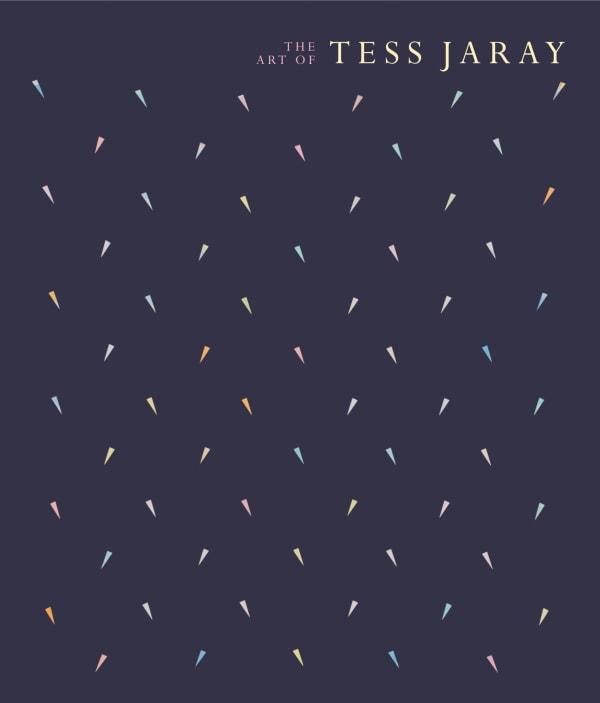Tess Jaray
Over the course of her distinguished career, Tess Jaray has developed a practice that despite sharing affiliations with minimalism, architectural drawing, Op Art and other movements, resists any singular classification.
Tess Jaray has explored the possibilities of creating space within abstract painting for more than six decades. She examines repetition, pattern and the relationship of size to scale within her surroundings, making paintings of spatial paradox in which the compositions seem to fluctuate between distance and closeness. Using line, colour and geometric forms, Jaray constructs a perception of evocative architectural spaces.
She first received critical acclaim in the early 1960s for her particular use of hard-edged painting. Critics noted how the colourful geometric constructions of the paintings were endowed with both a sober quality and expressive depth, evoking emotional responses. Jaray had created something with a controlled structure that also had an effect at a deeper level than the visual.
Tess Jaray was born in 1937 in Vienna, Austria, before coming to the United Kingdom in 1938 with her parents as part of the flight of Jewish refugees from the Nazis. The family settled in Worcestershire where Jaray grew up. She studied at Saint Martin's School of Art from 1954 to 1957 and at the Slade School of Fine Art, University College London from 1957 to 1960. In 1964 Jaray started teaching at Hornsey College of Art, working there until 1968 when she took up a role as the first female art teacher at the Slade School of Art, where she taught for three decades until 1999 when she was made Reader Emeritus.
Over the course of her distinguished career, Tess Jaray has developed a practice that despite sharing affiliations with minimalism, architectural drawing, Op Art and other movements, resists any singular classification. She has created her own pared-down visual language that focuses on the possibilities of space and how to express this through the reduction and control of form. Today Jaray continues to innovate and expand her practice from her studio in north London. She recently began to employ new geometric forms in her works.
An enduring facet in Jaray's art is the reduction of architectural form to the point of abstraction. The paintings transform architectural structures, details and surroundings into compositions that feel tangible yet distant through their use of geometry, colour, pattern, and perspective. Jaray examines with precision the deep and all-encompassing power of grand architecture and translates this experience onto a canvas, creating space, whether that be between the viewer and the artwork or within the painting itself. The viewer may perceive a three-dimensional form oscillating on the surface of the painting.
Jaray's work derives its refined aesthetic from a range of influences. The grand architecture of the Italian Renaissance and Baroque is a particular inspiration. First experiencing the art and architecture while travelling on a 'Grand Tour' of Italy in 1960, the formative experience of seeing these great works in their original setting prompted the artistic project that has engaged her for over half a century. She also finds inspiration in the formal abstraction of Islamic art and architecture, which she has gained through travels. Nonetheless, it is not only major monuments that interest the artist but also minutiae; the seemingly insignificant elements of a space that might easily be overlooked. Finding beauty in the ordinary, Jaray documents 'the detail'- the fragments of her surroundings - and subsequently reconceptualises this onto the canvas again.
Drawing is at the heart of Jaray's practice. She creates meticulous preparatory sketches and detailed drawings for all her paintings, and in doing so fills numerous sheets of paper, bringing together geometric forms and experimenting with them in patterns of varying complexity before finding one or two that would work on a larger scale. Jaray paints with flat brushstrokes, leaving a surface that to a large degree is devoid of any texture. She uses masking tape to map out her patterns on the canvas, the resulting finish is seamless. Combining colours of either tonal proximity or great contrast, she achieves a coalescence of dark and light. These colour relationships transform the compositions from simple geometric patterns to indeterminate, energetic spaces with forms that seem to be moving, suspended on the surface. The grounding colour of the painting's background further appears to control the movement of the forms.
Since the mid-1980s, Jaray has completed a succession of major art commissions in public places. The paving designs translate her patterns and ability to alter perception to a new platform, allowing people to orient themselves while treading the boundary between the feeling of stable ground and the instability of patterns. In Jaray's public commissions, her commitment to creating encompassing environments is also visible. On multiple occasions, this has involved designing not only the paving, but also railing, benches, walls and lampposts or combining the paving with paintings and prints. To this effect, she creates transitional spaces that negotiate different realms.
Biography by Viktoria Espelund
-
Tess JarayFor Your Eyes Only, Pink & Turquoise, 2020Acrylic on panel28.5 cm | 11 1/4 in diameter left panel
29.5 cm | 11 5/8 in diameter right panel -
Tess JarayIn and Out 4, 2020Acrylic on panel28 cm | 11 1/8 in diameter each panel
-
Tess JarayLines, 2020Acrylic on panel80 cm | 31 1/2 in diameter each panel
-
Tess JarayLove Match , 2020Acrylic on panel40 cm | 15 3/4 in diameter each panel
-
Tess JaraySolitude II, 2020Acrylic on canvas105 x 91 cm | 41 3/8 x 35 7/8 in
-
Tess JaraySolitude III, 2020Acrylic on canvas105 x 91 cm | 41 3/8 x 35 7/8 in
-

Paul Cezanne: Drawings | Tess Jaray: Roundels
10 - 30 Sep 2020 Room 2This exhibition brings together two artists in the two rooms of Karsten Schubert London's viewing space in an 18th-century terraced house in Soho: Paul Cezanne (1830–1909) and Tess Jaray (b. 1937).Read more -

London Original Print Fair 2020
New prints and editions 1 - 31 May 2020London Original Print Fair, Royal Academy of Arts, Alison Wilding, Tess Jaray, Bridget Riley, Sarah Kogan, Frances Richardson, Ann-Marie James, Cathie PilkingtonRead more -
Tess Jaray: Paintings from the 1980s
Viewing Room 23 Apr - 7 May 2020Karsten Schubert London presents Tess Jaray: Paintings from the 1980s , the first exhibition in a series of online programming. One of Europe’s most celebrated abstract painters, Tess Jaray (b....Read more -
Vienna Contemporary
12 Sep - 19 Oct 2019Karsten Schubert in collaboration with EXILE are pleased to present Tess Jaray’s work in two different locations in Vienna. Karsten Schubert and EXILE's stand at Vienna Contemporary Art Fair from...Read more
-

Tess Jaray
Elles font l'abstraction May 28, 2021Tess Jaray's work is featured in the major Centre Pompidou exhibition Elles font l'abstraction.Read more -

Tess Jaray: ‘I wanted to make space, to make something that you could disappear into’
Ben Luke for The Art Newspaper April 5, 2021Tess Jaray's interview with Ben Luke for The Art Newspaper is now accessible online. The intereview sheds light on how Piero della Francesca inspired her...Read more -

Tess Jaray’s From Piero and Other Paintings — shadows of the masters
By Rachel Spence for the Financial Times February 13, 2021Rachel Spence writes her response to From Piero and other paintings, Tess Jaray's solo exhibition at the New Art Centre, Salisbury in the Financial Times...Read more -

Return to Vienna: The Paintings of Tess Jaray
Secession January 5, 2021Tess Jaray returns to the city of her birth with this retrospective at the Secession, Vienna.Read more
-

Tess Jaray
Piero Inspirations Preface by Tess Jaray. Extracts by Roberto Longhi, 2021 HB, 48pp pages
Publisher: Ridinghouse
Dimensions: 31 x 24 cm Read more -

Tess Jaray
Into Light 2017 Softback, 50pp pages
Publisher: Marlborough Fine Art | Ridinghouse
ISBN: English
Dimensions: 29.7cm x 23.8 cm Read more -

Desire Lines
The Public Art of Tess Jaray Preface by Vivien Lovell, text by Charles Darwent, interview with the artist by Doro Globus, 2016 Softback, 96 pp, 67 colour ill. pages
Publisher: Ridinghouse 2016
Dimensions: 23 × 19.5 cm | 9 1/8 × 7 5/8 in Read more -

The Art of Tess Jaray
Texts by Richard Davey, John Stezaker, Alison Wilding, and an interview with the artist by Alister Warman Hardback, 256 pp, 198 colour ill pages
Publisher: Ridinghouse 2014 in association with Djanogly Art Gallery, Nottingham
Dimensions: 29.4 × 25.2 cm | 11 5/8 × 9 7/8 in Read more
















